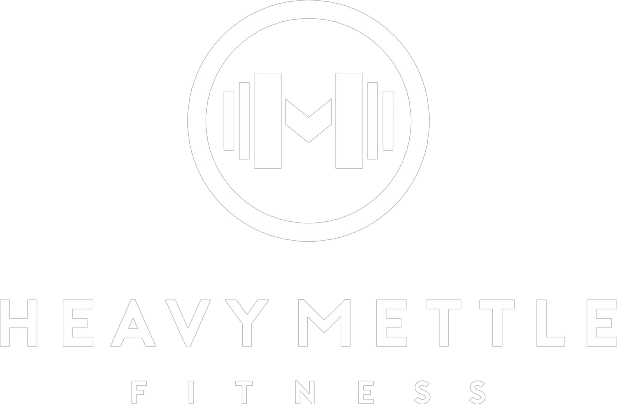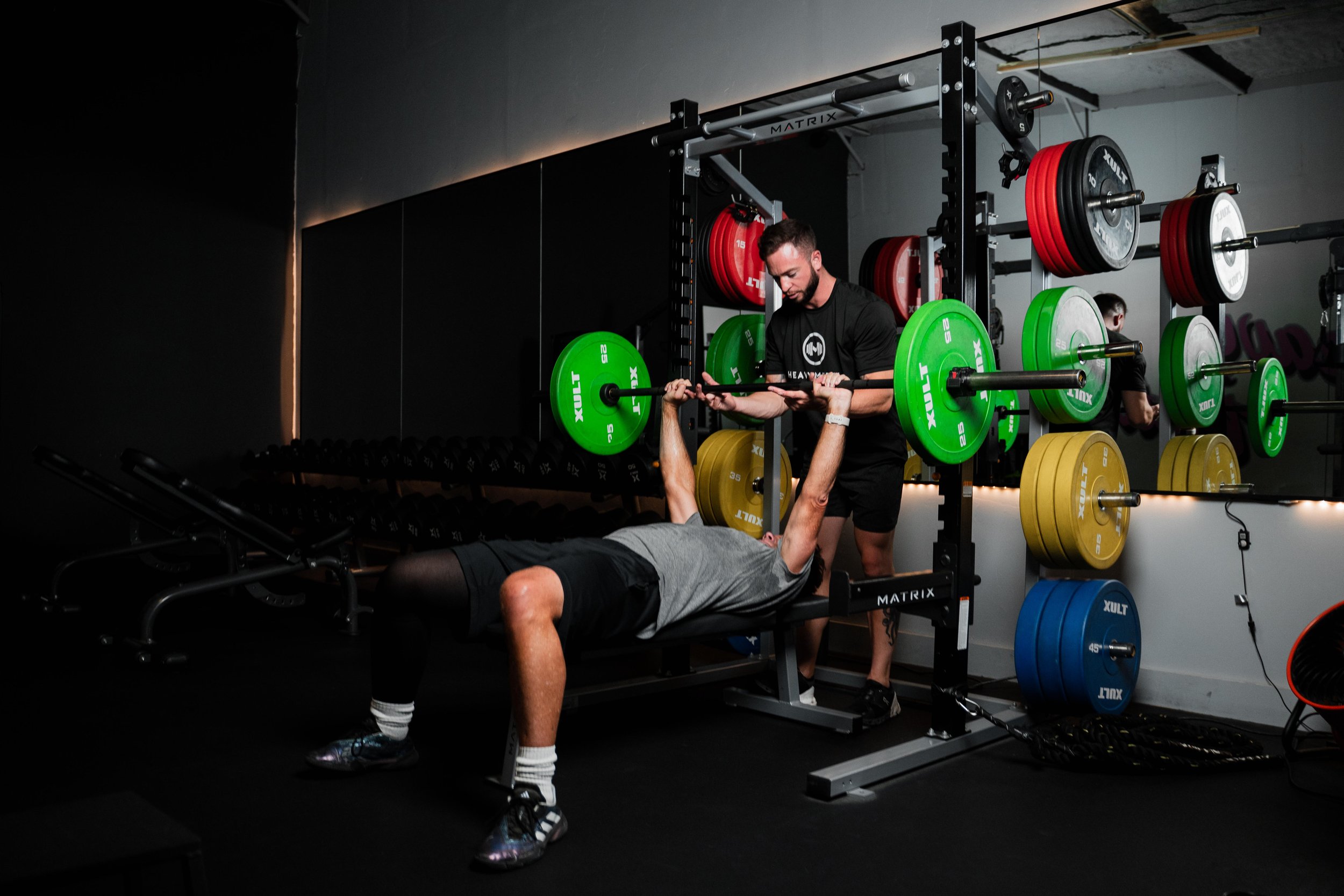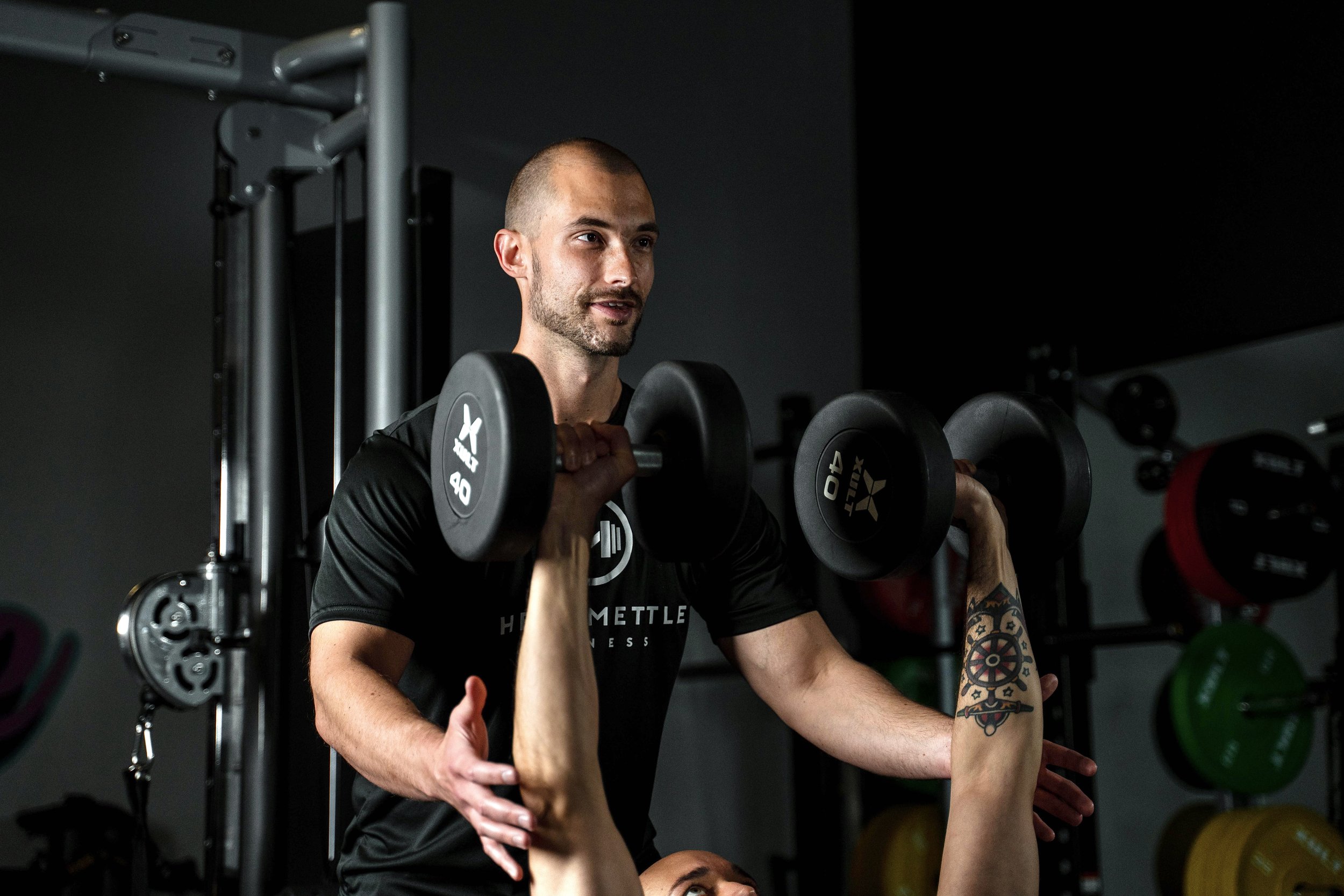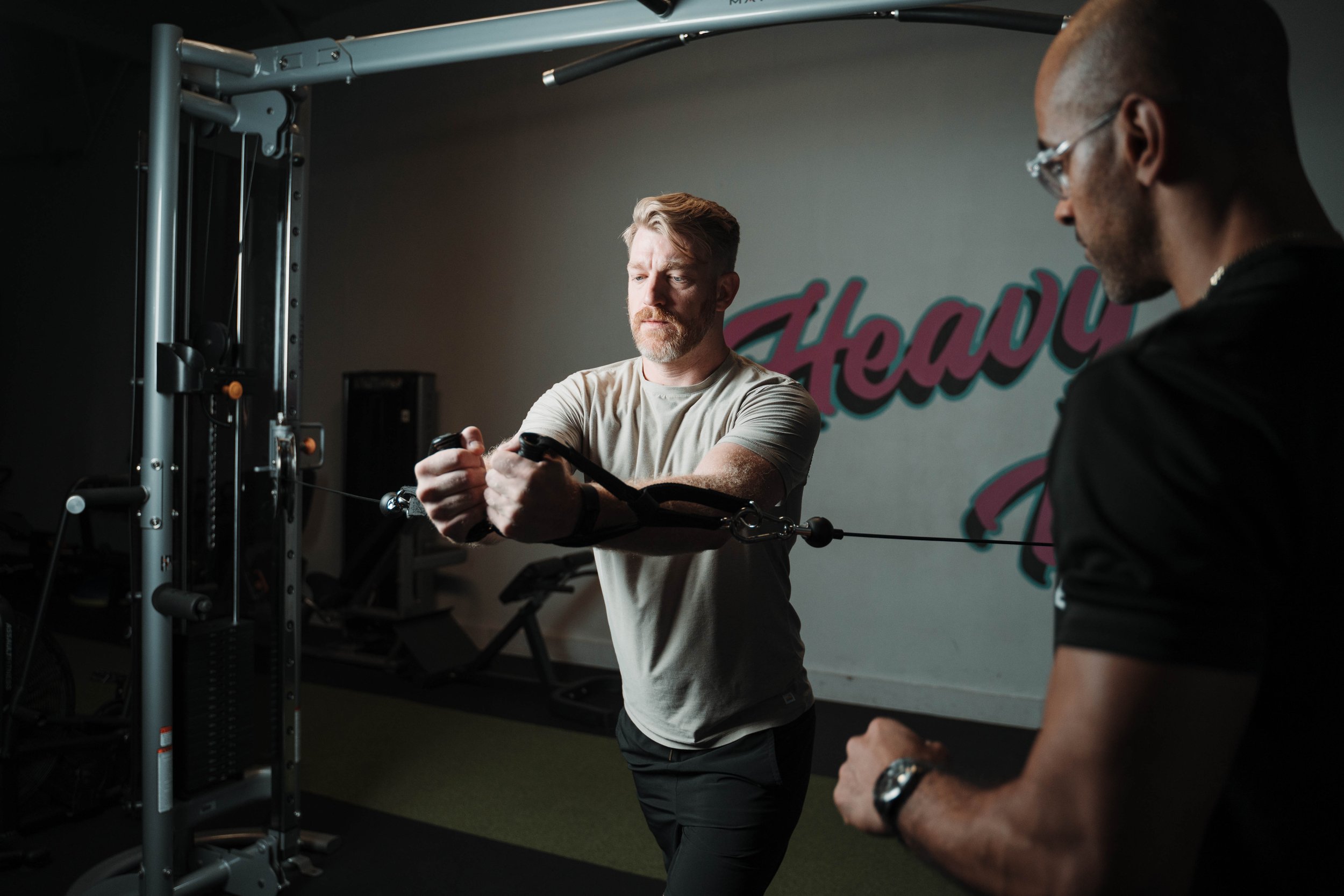Best Chest Workouts For Men
Building a strong, sculpted chest is a goal many men have with respect to their overall strength and fitness training regimen. The benefits of building a bigger and stronger chest go beyond simple aesthetic improvements. Chest muscles play an essential role in almost every upper body movement, from pushing your body off the ground to lifting and moving everyday objects. Whether aiming to boost athletic performance, improve posture, or simply enhance upper body development, chest workouts are immensely beneficial in helping men (and women) achieve these goals.
In this article, we'll dive into the best chest exercises to support a strength training regimen for all fitness levels. As a certified personal trainer in Austin, Texas, I've worked with hundreds of clients who all have similar goals: improving their physique and body composition. Sculpting a bigger chest can be essential for men looking to improve their overall strength and physical appearance.
We'll discuss chest workouts at the gym, chest workouts at home, dumbbell chest workouts, chest workout machines, cable chest workouts, and the best upper chest workouts!
Coming Up:
How to Grow Your Chest
Top 5 Chest Workouts
Best Upper Chest Exercises
Tips For Optimizing Your Chest Workouts
How to Grow Your Chest
Building muscle is one of the most commonly sought-after fitness goals. As such, it can be one of the most demanding and challenging goals to achieve. However, building muscle can become a reality through a properly structured weight training and nutrition regimen!
Building a well-defined chest through strength training requires careful planning and a consistent effort in the gym. Progressive overload is a primary factor with respect to hypertrophy (muscle growth). Progressive overload means gradually increasing the resistance (weight) being lifting over time to consistently challenge our muscles.
If you're lifting the same weight for a prolonged and sustained period of time (months or even years), your body will eventually adapt to this degree of load and stimulus, and muscle growth will plateau. As a personal trainer I often recommend to my clients that they should aim to increase the weight, reps, or overall intensity of their workouts as they progress and feel stronger to avoid such plateaus (when safe to do so).
Program design is also a critical component of a properly executed strength training regimen. For starters, it's essential to understand the difference between compound exercises and isolation exercises. Compound exercises generally require more energy and physical exertion than isolation exercises; as such, a workout plan should prioritize compound exercises and aim to complete them before moving on to isolated exercises. Both of these forms of exercise can be beneficial for muscle growth; it's just that energy prioritization is often an overlooked aspect of workout planning and design.
Proper form is also essential for long-term and sustainable muscle growth to maximize results and avoid injury. When performing most chest-focused exercises, keeping one's shoulders retracted to minimize their involvement can emphasize chest engagement and prevent potential shoulder-related injuries. For pressing movements, I often recommend to my clients that they use a controlled tempo to engage the muscles fully, slowly allowing the resistance to approach the body and respond with a fast and powerful push away from the body. This approach can result in greater muscle fiber recruitment, optimizing the potential for hypertrophy and strength gains.
For those who consider themselves to be beginners in the gym or anyone looking for more help with form, consider hiring a personal trainer to help you construct an effective training program and navigate the weight room safely!
Finally, it's essential to also consider and prioritize recovery. Muscle growth doesn't actually happen during strength workouts. Instead, it occurs predominantly in the recovery period afterward (mostly during sleep). So, when prioritizing muscle growth, be sure to give your chest muscles enough time to repair before completing another chest workout. I often recommend to our clients at Heavy Mettle Fitness that they allow for a minimum of 48 hours between workouts that target the same muscle groups.
Significant muscle gains don't come overnight, but pair a properly structured and executed weight training regimen with proper nutrition and recovery, and consistent gains in hypertrophy and strength can be expected in relatively short order!
Top 5 Chest Workouts (Best Chest Exercises)
Muscle mass can be developed and enhanced with a myriad of chest exercises. So, there's not necessarily one single strength training routine that needs to be adhered to in order to build a bigger and stronger chest. However, there are some chest exercises that can offer more "bang for your buck," so to speak. We'll discuss those chest workouts for men below.
When designing your own strength training routine, be sure to consider your own health and injury history, as some exercises are not suitable for some people.
Barbell Bench Press
The barbell bench press is one of the most well-known and effective chest exercises for men looking to enhance upper body strength and size. This compound movement (multi-joint exercise) primarily targets the chest muscles, specifically the pectoralis major, but it also engages the shoulders (anterior deltoids) and triceps. The sheer volume of muscles activated and engaged throughout the bench press makes it an incredibly efficient strength training exercise for overall upper body development with respect to both size and strength.
Beyond building muscle size and strength, the bench press improves pushing power and output, which translates to better performance in various sports and daily activities that involve upper body movements (especially pushing movements).
Proper execution of the barbell bench press involves lying flat on a bench with one's feet firmly planted on the ground for stability (a firm base also helps to generate more force, which helps with the upward motion of the movement). Ideally, the body will be positioned on the bench so that one's eyes are directly under the barbell. The grip on the barbell should result in the hands being slightly wider than shoulder-width apart, ensuring a strong, even grip. Before unracking the bar, the shoulder blades should be retracted and laid flat on the bench to create a solid base and avoid excess strain on your shoulders. A slight lower back arch is natural, but the shoulder blades and glutes should remain in contact with the bench at all times to avoid excessive curving and strain of the spine. Engaging the abdominals throughout the movement can help to stabilize the spine throughout this exercise.
When beginning the exercise, the user should unrack the barbell carefully and hold it directly over their chest with arms fully extended. From there, the actual bench pressing movement is initiated by lowering the bar in a slow, controlled motion until it lightly touches the middle of the chest (around the nipple area). Users should take care to avoid allowing the bar to bounce off their chest, as this could lead to injury. Once the bar reaches the body, a strong push of the barbell back up should be initiated with a high level of force while engaging the chest and triceps, ensuring the bar follows a straight path back up over the chest. This process can be repeated for the desired number of reps. As a certified personal trainer, I always recommend to my clients that they prioritize control and form over lifting as heavy as possible.
Breathing: Controlling one's breathing during the barbell bench press is essential for strength and safety. I recommend to my clients that they inhale as the barbell is coming down toward the body and that they breathe out as they push the barbell back up toward the ceiling.
Incline Dumbbell Chest Press
As a natural bodybuilder and certified personal trainer, the incline dumbbell chest press is one of my favorite chest exercises for men, and I consider it one of the best dumbbell chest workouts overall. It is a highly effective exercise for targeting the upper portion of the chest muscles, which is notoriously difficult for most men to develop to a significant degree. Similar to the barbell bench press, the incline dumbbell chest press also works the shoulders (front deltoids) and triceps, making it a great option for building both strength and muscle mass in the upper body.
One key benefit of using dumbbells for a chest exercise as opposed to a barbell is the increased range of motion, which allows for a deeper stretch in the chest. Additionally, dumbbell chest workouts require both arms to work independently, helping to address muscle and strength imbalances and improve overall stability.
Another benefit to dumbbell chest exercises, as opposed to barbells, pertains to those who have previous or current shoulder injuries or concerns. Dumbbells allow for an adjustment of the angle at which a pressing and lowering movement can be conducted. Angling the elbows closer to 45 degrees, as opposed to 90 degrees, is often a less painful or uncomfortable approach, making this a practical means of training the chest muscles for individuals with shoulder issues.
To perform the incline dumbbell chest press exercise correctly, one can begin by adjusting an adjustable bench to an incline angle of about 30 to 45 degrees. From there, the user will sit on the bench with a dumbbell in each hand, resting them on their thighs while keeping their back straight and upright. Then, they'll slowly lean back and position the dumbbells at shoulder height, with the elbows bent and their palms facing forward. Similar to the barbell bench press, it's important to keep feet flat on the ground and the lower back slightly arched but supported by the bench by keeping the glutes in contact with the bench at all times. Retracting the shoulder blades will help to create a stable pressing base and protect the user's shoulders during the exercise.
When ready, the user will press the dumbbells up and slightly inward (bringing dumbbells toward each other) until the arms are fully extended but without locking the elbows out. It's important to exhale during the upward pushing part of the movement. After a brief pause at the top, the user will lower the dumbbells in a slow and controlled motion until the forearm creates a 90-degree angle relative to the biceps. From here, the exercise can be repeated for the desired number of reps while always maintaining control of the weights to prevent injury.
Cable Chest Flye
The cable chest flye is a popular isolation exercise designed to target the chest muscles, specifically the pectoralis major. Unlike compound exercises like the barbell bench press, the cable chest flye is focuses more on engaging the chest without help from supporting muscle groups, like the shoulders. This allows for another means of stimulating growth in the chest.
One of the most significant advantages of using cables for chest flyes, as opposed to dumbbells, is the consistent tension they provide throughout the entire range of motion, which can help to maximize muscle engagement.
To perform the cable chest flye properly, one should start by setting the pulleys on a cable machine to be level with the middle of the chest. From there, the handles should be attached to the cables, and the user can then grab one in each hand. With the cables in each hand, the user will take a step forward with a stagnated stance for stability, keeping a slight bend in their knees and positioning themself in the center of the machine. The arms should be outstretched in front of the body, but with a slight bend in the elbows to protect the joints. One should avoid locking their arms or letting them fall below shoulder height. An upright posture should be established and maintained throughout the movement by engaging the core and keeping the back straight, with a slight forward lean at the waist to maintain balance and proper alignment.
The movement begins by bringing the handles together in front of the body in a wide, sweeping motion as if to hug a large barrel or tree. The hands should meet just before the point of contact in a neutral grip position (thumbs toward the ceiling with pinkies toward the floor). There should be a short pause at the point when the hands meet; this will exaggerate the squeeze and feeling of tension throughout the chest. Then, the user will allow their arms to slowly return to the starting position while maintaining that slight bend in their elbows. One should be mindful to avoid letting the weights pull their arms back too far, as this can strain the shoulders. These steps can be repeated for the desired number of repetitions, focusing on a smooth, controlled movement.
Machine Chest Press
The machine chest press is a versatile strength training exercise for any gym-goer but, especially those with shoulder concerns/issues. This chest exercise also engages supporting muscle groups like the triceps and anterior deltoids, making it a great choice for overall upper-body development. The machine chest press is also great for beginners as it provides a guided motion, which can reduce the risk of improper form. Additionally, the fixed pathway of the machine allows a safer means of lifting heavier weights, helping to enhance strength and muscle mass.
To perform the machine chest press properly, one should start by adjusting the seat height so the handles are at chest level when seated. The back should rest comfortably against the pad, with the feet remaining flat on the floor for stability. The hands should be placed on the handles with an overhand grip, keeping the wrists straight and elbows bent at roughly 90 degrees. The shoulders should be pressed back against the seat, creating a firm base of support and preventing unnecessary strain on the shoulders.
The movement begins by pushing the handles forward by extending the arms and exhaling as the press is nearly completed. One should avoid locking their elbows at the end of the movement to maintain tension on the target muscles. After a brief pause at the end of the extension, one can then slowly return the handles to the starting position by bending the elbows and controlling the movement on the way back. This process can be repeated for the desired number of reps while being mindful to maintain focus on proper alignment and a controlled pace for the best results.
Push Ups
Push-ups are a great chest workout that can be done at home and with no equipment. They're also a great chest workout for beginners, although they have a low ceiling with respect to the development of muscle size and volume since it's a relatively difficult exercise to increase load and stimulus with, although not impossible.
To perform a proper push-up, the user can start in a high plank position with their hands placed slightly wider than shoulder-width apart, arms straight, and body forming a straight line from head to heels. The user should engage their core by tightening their abdominal muscles and keep their neck neutral by looking slightly forward. The body will be lowered toward the ground by bending the elbows, being mindful to keep them at about a 45-degree angle to the torso until the chest is just above the ground. From this position, the body will be pushed back up to the starting position by straightening the arms, ensuring the body remains in a straight line throughout the movement.
When performing this exercise with clients at Heavy Mettle Fitness in Austin, Texas, I often encourage them to focus on feeling the stretch through the chest on the way toward the floor and then the squeeze in the chest on the way back up from the floor. Doing so can help ensure the intended muscle groups are being emphasized throughout the exercise.
For beginners, modifications like kneeling push-ups or incline push-ups (placing the hands on an elevated surface) can help build strength with this chest exercise.
For those looking for chest workouts with no equipment, it's difficult to rival a solid set of push-ups!
Best Upper Chest Workouts
For most men, developing a strong and "built" upper chest is usually one of the most challenging feats. To clarify, the upper chest is essentially the top half of the chest that sits just under the collarbone. Just like training any other muscle group or body part, developing a stronger and larger upper chest requires training volume, persistence, and time. Some exercises are better than others when targeting this area of the chest. Below, we'll discuss some of my favorite workouts for the upper chest!
Incline Dumbbell Chest Press
The incline dumbbell is one of my favorite upper chest exercises for men. This exercise is great for overall chest development, as we discussed earlier, but this is one of the best upper chest exercises!
Incline Barbell Bench Press
The incline barbell bench press is a variation of the traditional bench press (which we discussed earlier) that focuses on developing the upper portion of the chest, specifically the clavicular head of the pectoralis major. Much like the traditional flat bench press exercise, the incline version of this movement also engages supporting muscles like the triceps and the shoulders. The versatility of this exercise makes it a well-rounded exercise for upper body strength and aesthetics.
By positioning the bench at an incline, typically between 30 to 45 degrees, this exercise shifts greater emphasis to the upper chest by moving the line of gravitational force from the middle of the chest to the upper half. Placing emphasis on the top half of the chest in this way can help create a more developed and fuller look to the torso. This chest exercise is an excellent choice for those wanting to balance their chest development or improve their strength and explosive performance in pushing movements.
To perform the incline barbell bench press correctly, the user will start by adjusting the bench to the desired incline angle, typically 30 to 45 degrees, which can emphasize activation throughout the upper chest without placing unnecessary strain on the shoulders. Much like the flat variation of the barbell bench press, the person will lie with their shoulder blades retracted on the bench, their glutes will be in contact with the bench, and their feet will be flat on the ground to create stability.
From here, they will position themselves so their eyes are directly beneath the barbell with a hand grip on the bar slightly wider than shoulder-width. The wrists should be straight and stacked over the elbows to maintain control throughout the movement.
When ready, the user will lift the barbell and position it above the upper chest with their arms fully extended. They'll begin to lower the barbell in a controlled motion toward the chest, approximately at collarbone level, making sure to keep their elbows at an angle rather than excessively flared out. It's important to exhale as the barbell is pressed back up toward the starting position, as this can release pressure off the neck and ensures the bar stays on a smooth and controlled path. Participants should take care to avoid bouncing the weight off the chest or overextending the elbows at the top.
Incline Cable Chest Press
The incline cable chest press is a versatile chest exercise for men designed to target the upper portion of the chest. This cable chest workout also engages secondary, or supporting, muscles like the anterior deltoids (front of the shoulders) and triceps, contributing to overall upper body development. The cable variation of a chest press allows for constant tension throughout the exercise, which enhances muscle fiber engagement and promotes the enhancement of overall stability. Thus, the incline cable chest press is an excellent chest exercise for building strength and increasing muscle development in the upper chest.
To perform the incline cable chest press exercise, one can begin by setting the pulleys on a cable crossover machine or functional trainer to just below hip height or slightly lower, depending on the individual's range of motion. In a standing position, the user will face away from the machine and stand in a staggered stance (one foot in front of the other). A cable should be held in each hand with a pronated grip )palms facing the floor). The movement will begin by pressing the hands and elbows toward the ceiling at about a 45-degree angle. During the pressing portion, the elbows should be almost directly below the hands. This portion of the exercise should finish with the elbows nearly locked out and the hands around forehead height. The user should feel a squeezing sensation through the chest during this pressing movement. Once the pressing motion is completed, the user will slowly bring the hands and elbows back toward the body. Once the hands are nearly in line with the chest, the repetition will begin again with a pressing motion back toward the ceiling. The user should be careful to keep their core engaged and avoid letting the cables pull their arms too far back, which could strain the shoulders. This process can be repeated for the desired number of repetitions. Control of form and tempo is essential for a safe and effective cable chest workout, regardless of the exercise!
Tips For Optimizing Chest Workouts
As a certified personal trainer, I always advise my clients to approach every workout, regardless of which muscle group is being targeted, with a plan. Nothing kills or stalls progress greater than an aimless workout regimen. I encourage them to prioritize exercises that demand the most energy expenditure and incorporate them at the beginning of a workout routine. From there, they can incorporate more "accessory movements". In the context of a chest workout, this might mean that someone will begin the workout with the barbell bench press and follow it with a cable chest flye.
It's also important to emphasize form and technique over simply trying to lift as heavy weights as possible. If the goal is to enhance muscular development and sculpt a larger chest, then it's essential to ensure that maximal load is placed on the chest muscles rather than supporting muscles like the shoulders or the triceps as a result of the weight being too challenging for the user.
Consistency is also crucial for achieving success in the gym. Building muscle, regardless of the group, is a difficult process that requires high effort over a long period of time. If someone is expecting to build significant muscle mass (visible in the mirror) in 30, 60, or even 90 days, this would be an unrealistic goal. If one's goal is to build a great looking physique, consider making resistance training a routine part of one's lifestyle rather than a temporary challenge or endeavor.
Chest Exercises For Men
Many gym goers, especially men, want to build a defined and muscular-looking chest. Just like any other muscle group, building a well-developed chest requires time, effort, and consistency. The chest exercises discussed in this article might not be suitable for everyone, especially those with shoulder injuries or concerns, but for the typical healthy lifter, these exercises offer an opportunity to challenge the chest muscles and sculpt a larger and more pronounced chest.
Please note that I am not a medical professional, and you should always consult with your doctor before beginning an exercise and/or nutrition regimen. The information discussed in this article is not personal advice to readers; it is simply meant to be informative.







